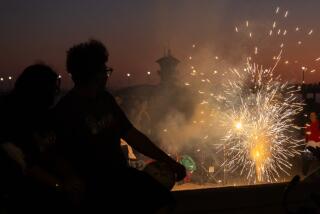Fuse Is Lit for Fireworks Shows : Tips on How to Have a Safer and Saner Fourth of July
- Share via
To the true fireworks fan, one’s own backyard display is a celebration of America. For the manufacturers of those fireworks, the Fourth of July is enough to keep them fiscally solvent for the rest of the year.
Southern California firefighters, however, see backyard fireworks in their nightmares. To them, they mean burning buildings, injuries and a frantic, dangerous weekend. “Safe and sane” fireworks, they say, aren’t.
Traditionally, neither side has been willing to budge. But in the continuing battle over sparklers and Vesuvius fountains, the anti-fireworks camp has in recent years seemed to be gaining the upper hand. Each year, fire authorities say, more and more Southern California cities are banning “safe and sane” fireworks.
“What’s happening is that each year another city bans fireworks,” said Los Angeles County Fire Department Battalion Chief Gordon Pearson. “Cities are becoming more and more cognizant of the fact that fireworks cause injuries.”
Fireworks manufacturers, however, maintain that illegal fireworks, not “safe and sane” ones, are responsible for the mischief.
“Most people are misinformed about the statistics and the reasons cities ban fireworks,” said Ralph Apel, vice president of operations for Red Devil Fireworks, a “safe and sane” fireworks manufacturer. “There are cities that (ban fireworks) and still have heavy losses and injuries, because the real offenders are bottle rockets.”
Bottle rockets, illegal in California, are small projectiles that can be propped up inside the neck of a bottle and shot into the air.
“Safe and sane” fireworks, said Apel, do not explode or fly into the air. Essentially, he said, they do only two things: emit showers of sparks and whistle.
Apel offered these safety tips for those who live in communities where backyard fireworks are still legal:
Decide on the Area
“The best thing is to plan the display early in the day and decide on the area, making sure it’s free of debris and trees and leaves on the ground. Then designate the person who’s going to light the fireworks and make everyone else the spectators and put them about 20 feet away.”
During the display, he said, the designated pyrotechnician should light only one item at a time and, when it burns itself out, it should be dunked into a ready bucket of water.
“If you take time to plan and observe a few safety rules,” Apel said, “you should have yourself an extremely safe show.”
Jim Souza of Pyro Spectaculars, the Rialto-based business responsible for the fireworks at the 1984 Olympic Games at Los Angeles, the Golden Gate Bridge 50th anniversary celebration and part of last year’s massive Statue of Liberty celebration, echoes Apel’s sentiments.
Fireworks of any kind, he said, are safe when handled safely.
‘I’m Pro-Fireworks’
“I’m definitely pro-fireworks,” Souza said. “I grew up with them and I know that it can be done safely. For people who want to put on a display in their backyard, I’d tell them to try to put on a nice show, get the family together, have a bucket of water and the hose running and keep the fireworks away from anything flammable. They might want to use a board to set them on. If you use them as they’re designed to be used, they’re basically harmless. It’s when people throw them or place them where they don’t belong that you have problems.”
When it comes to the legality of fireworks, Southern California is a checkerboard. While it may be legal to buy and shoot off fireworks in, say, Santa Ana, it is illegal in neighboring Tustin.
Here is how cities in five Southern California counties handle the “safe and sane” fireworks question:
LOS ANGELES COUNTY
“Safe and sane” fireworks are legal in the following cities: Alhambra, Arcadia, Artesia, Azusa, Baldwin Park, Bellflower, Bell, Bell Gardens, Carson, Cerritos, Commerce, Compton, Downey, Duarte, El Monte, Hawaiian Gardens, Hawthorne, Huntington Park, Industry, Inglewood, Irwindale, Lakewood, La Mirada, La Puente, La Verne, Lawndale, Lynwood, Maywood, Montebello, Monterey Park, Norwalk, Palmdale, Paramount, Pico Rivera, Rosemead, Santa Fe Springs, South El Monte, South Gate, Temple City, Walnut and West Covina.
They are illegal in all unincorporated areas of the county and all communities within the city of Los Angeles.
ORANGE COUNTY
“Safe and sane” fireworks are illegal in these cities: Anaheim, Brea, Irvine, Laguna Beach, La Habra, La Palma, Los Alamitos, Newport Beach, Seal Beach, Tustin and Yorba Linda. They are legal in all unincorporated areas of the county except grassland and wild areas closed to the public.
SAN BERNARDINO COUNTY
Cities that have declared “safe and sane” fireworks legal are: Adelanto, Chino, Colton, Fontana, Rialto, Victorville, Rancho Cucamonga and San Bernardino--in certain sections. (Fireworks are illegal on all land north of 40th Street in the city of San Bernardino. They are also forbidden in certain spots in or near the dry foothills within the city limits. Anyone unsure of fireworks laws in any area of the city is encouraged to call the San Bernardino Fire Department for information.)
Fireworks are illegal in all unincorporated areas of the county and in all national forest areas.
VENTURA COUNTY
Only the city of Fillmore allows “safe and sane” fireworks.
RIVERSIDE COUNTY
“Safe and sane” fireworks are illegal throughout Riverside County.
More to Read
Sign up for Essential California
The most important California stories and recommendations in your inbox every morning.
You may occasionally receive promotional content from the Los Angeles Times.










